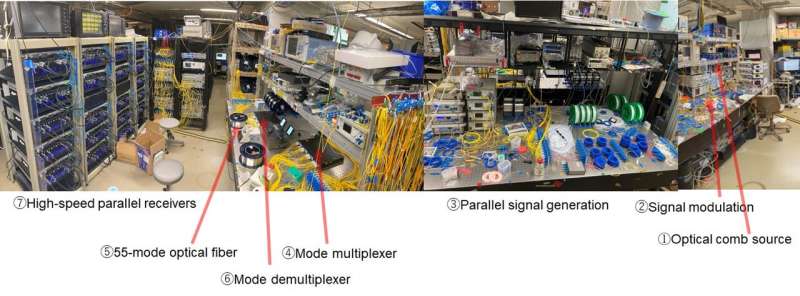1.53 petabit per second transmission in 55-mode fiber with standard cladding diameter

The world's first 55-mode transmission at a record data-rate of 1.53 petabits per second in any standard cladding diameter optical fiber was demonstrated. This novel 55-mode fiber enables ultra-high spectral efficiency with high-data-rate achieved using only the most common optical communications (C-) band. This demonstration shows the potential of multi-mode transmission for future high-capacity backbone networks
A group of researchers from the Network Research Institute of the National Institute of Information and Communications Technology (NICT, Japan) led by Georg Rademacher in collaboration with Nokia Bell Labs (U.S.), Prysmian Group (Prysmian, France, and the Netherlands), and the University of Queensland (Australia) succeeded in the world's first large-capacity transmission experiment with large mode multiplexing technology using 55 modes.
The experiment also reports data-rate of 1.53 petabits per second, a record in any standard cladding diameter (0.125 mm) optical fiber to date. 55 modes were successfully multiplexed throughout the commercially adopted optical fiber transmission window (C-band), with a dramatic increase in spectral efficiency compared to conventional fibers and previous multi-mode transmission. A further expansion of transmission capacity can be anticipated by combining this technology with multi-band wavelength-division multiplexing technology.
This demonstration serves as an important step in the maturity of high mode-count multi-mode transmission technology and the development of Beyond 5G and subsequent information and communications infrastructure technology.

In recent years, transmission systems using advanced optical fibers with the same cladding diameter as standard single-mode fibers, but able to support multiple propagation paths have been investigated. NICT constructed transmission systems using either a standard cladding diameter 4-core optical fiber and a single-core 15-mode optical fiber, succeeding in transmission experiments at 1 petabit per second with both fibers.
The number of cores in standard cladding diameter multi-core fibers is limited by inter-core crosstalk, but further increasing the number of spatial channels in standard diameter optical fiber is still possible by enlarging the core of a multi-mode fiber. However, the propagation characteristics for each mode can vary something leading to degradation of the signal quality and an increase in signal processing complexity. Hence, increasing the mode-count requires precisely engineered components such as multiplexers and fiber as well as complex processing techniques to recover the signals after mode-mixing and enable large-capacity transmission beyond the 15-modes already demonstrated.
NICT has constructed a transmission system using Prysmian's single-core 55-mode optical fiber and a mode multiplexer/demultiplexer designed and manufactured by Nokia Bell Labs and the University of Queensland. Using these components, the group has successfully transmitted a total of 1.53 petabits per second over 25.9 km.
To evaluate the 55-mode signal, we constructed a high-speed, parallelized receiver system. The 55- independent signal streams could then be separated by 110 x 110 MIMO processing to recover the transmitted data. We could successfully receive polarization multiplexed 16 QAM signals at 184 wavelengths in the C wavelength band. Compared with the previous 15-mode multiplexed transmission, the spectral efficiency has improved by more than three times (332 bits/s/Hz) with the increase in the number of modes.

This demonstration showed that with such high spectral efficiency only use of the C-band was needed to transmit more than 1.5 Pb/s and so further expansion can be expected by adopting multi-band wavelength-division multiplexing in the future.
At present, the Beyond 5G (6G) information communications society is being promoted around the world. As the amount of network devices and data traffic continues to increase, study of information and communication infrastructure technology for the post Beyond 5G era must also be investigated. This achievement is an important technological step towards this goal.
In the future, we will explore further transmission capacity by expanding the frequency band, as well as fundamental technologies necessary for long-distance transmission and network deployment.
The results of this experiment were accepted as a post-deadline paper presentation at the 48th European Conference on Optical Communication (ECOC 2022) and presented on Thursday, September 22, 2022.


















